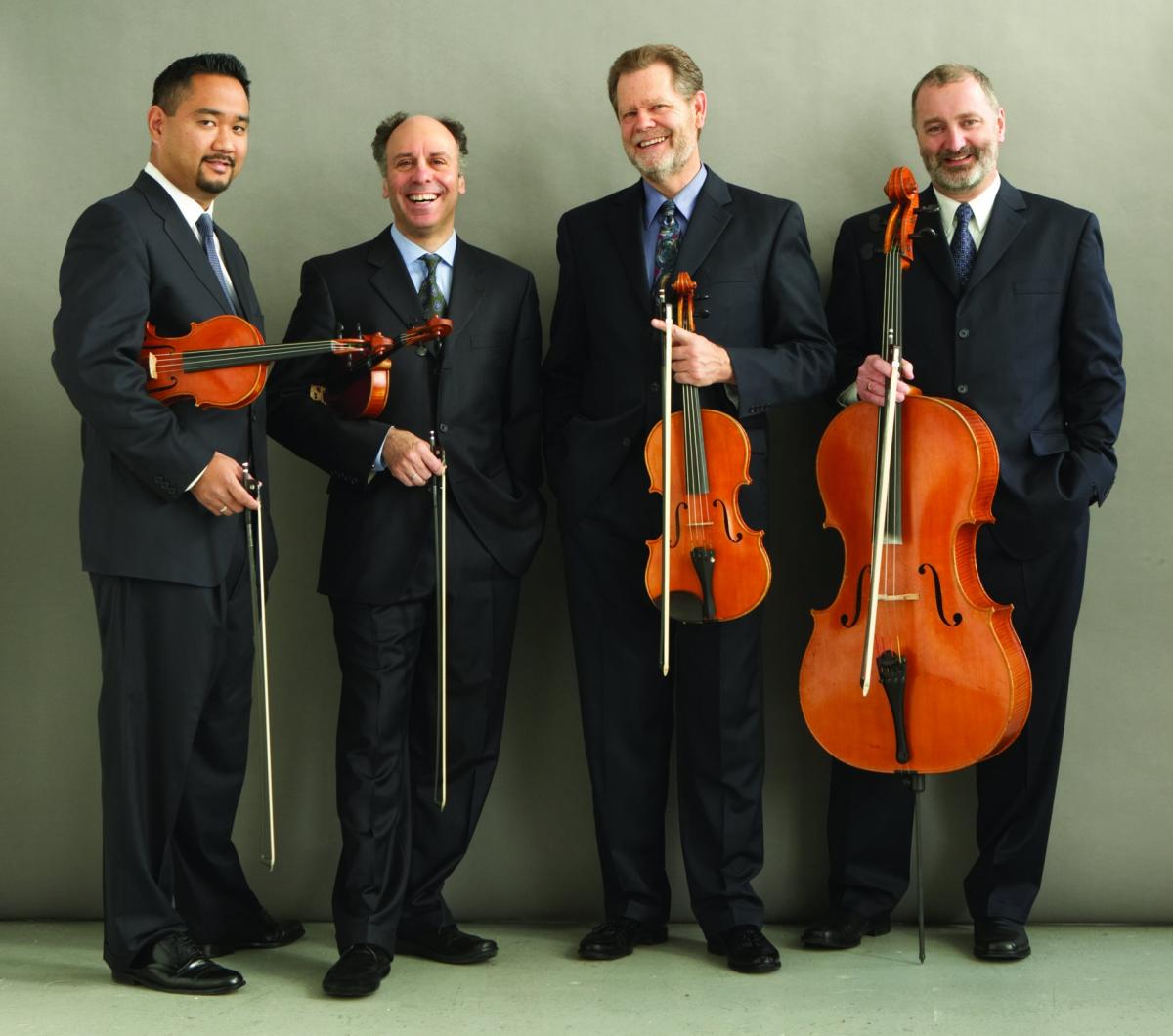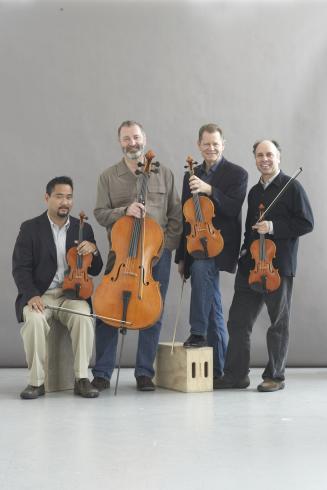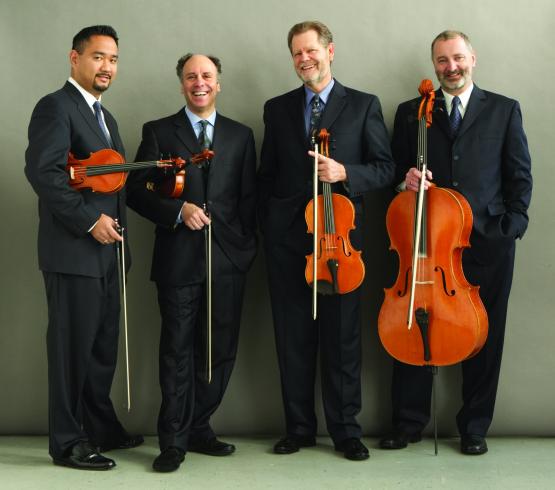Alexander String Quartet
String Quartet

The San Francisco based Alexander String Quartet will perform works by Kodály, Shostakovich, and a new quartet by British composer Tarik O’Reagan in their Phillips Music debut.
Program
Founded in New York City in 1981 and based in San Francisco, the Alexander Quartet has long been established as one of the finest string quartets in the US. The program includes Kodály’s memorably beautiful String Quartet No. 2, completed in 1918 and influenced by Debussy’s Quartet, as well as Shostakovich’s String Quartet No. 9, composed in 1964, one of his most outgoing quartets dedicated to his third wife. These two 20th-century classics flank a new quartet by British composer Tarik O’Reagan. His work, Gradual, was written for the Alexander Quartet and first performed by them in Boise, Idaho, in October 2016.
Please note that this concert takes place at the Cosmos Club, 2121 Massachusetts Ave., NW.
About the Artists
The Alexander String Quartet, comprised of violinists Zakarias Grafilo and Frederick Lifsitz, violist Paul Yarbrough, and cellist Sandy Wilson, celebrated its 35th Anniversary in 2016, and has performed in the major music capitals of five continents, securing its standing among the world’s premier ensembles. Widely admired for its interpretations of Beethoven, Mozart, and Shostakovich, the quartet’s recordings of the Beethoven cycle (twice), Bartók, and Shostakovich cycle have won international critical acclaim. The quartet has also established itself as an important advocate of new music through over 30 commissions from such composers as Jake Heggie, Cindy Cox, Augusta Read Thomas, Robert Greenberg, Martin Bresnick, Cesar Cano, and Pulitzer Prize-winner Wayne Peterson. A new work by Tarik O’Regan, commissioned for the Alexander by the Boise Chamber Music Series, had its premiere in October 2016, and a work for quintet from Samuel Carl Adams is planned for premiere in early 2019 with pianist Joyce Yang.
The Alexander String Quartet is a major artistic presence in its home base of San Francisco, serving since 1989 as Ensemble in Residence of San Francisco Performances and Directors of the Morrison Chamber Music Center in the College of Liberal and Creative Arts at San Francisco State University.
The Alexander String Quartet’s annual calendar of concerts includes engagements at major halls throughout North America and Europe. The quartet has appeared at Lincoln Center, the 92nd Street Y, and the Metropolitan Museum in New York City; Jordan Hall in Boston; the Library of Congress and Dumbarton Oaks in Washington; and chamber music societies and universities across the North American continent. This past summer, the quartet returned as faculty to the Norfolk Chamber Music Festival, a nexus of their early career. Recent overseas tours have brought them to the U.K., the Czech Republic, the Netherlands, Italy, Germany, Spain, Portugal, Switzerland, France, Greece, the Republic of Georgia, Argentina, Panamá, and the Philippines. They returned to Poland for their debut performances at the Beethoven Easter Festival in 2015.
Among the fine musicians with whom the Alexander String Quartet has collaborated are pianists Joyce Yang, Roger Woodward, Anne-Marie McDermott, Menachem Pressler, Marc-André Hamelin, and Jeremy Menuhin; clarinetists Joan Enric Lluna, David Shifrin, Richard Stoltzman, and Eli Eban; soprano Elly Ameling; mezzo-soprano Joyce DiDonato; violinist Midori; cellists Lynn Harrell, Sadao Harada, and David Requiro; and jazz greats Branford Marsalis, David Sanchez, and Andrew Speight. The quartet has worked with many composers including Aaron Copland, George Crumb, and Elliott Carter, and has long enjoyed a close relationship with composer-lecturer Robert Greenberg, performing numerous lecture-concerts with him annually.
The Alexander String Quartet added considerably to its distinguished and wide-ranging discography over the past decade, now recording exclusively for the FoghornClassics label. There were three major releases in the 2013/2014 season: The combined string quartet cycles of Bartók and Kodály, recorded on the renowned Ellen M. Egger matched quartet of instruments built by San Francisco luthier, Francis Kuttner (“If ever an album had “Grammy nominee” written on its front cover, this is it.” –Audiophile Audition); the string quintets and sextets of Brahms with Toby Appel and David Requiro (“a uniquely detailed, transparent warmth” –Strings Magazine); and the Schumann and Brahms piano quintets with Joyce Yang (“passionate, soulful readings of two pinnacles of the chamber repertory” –The New York Times). Their recording of music of Gershwin and Kern was released in the summer of 2012, following the spring 2012 recording of the clarinet quintet of Brahms and a new quintet from César Cano, in collaboration with Joan Enric Lluna, as well as a recording in collaboration with the San Francisco Choral Artists. A recording of works by Cindy Cox was released in 2015. Their recording of the Mozart “Prussian” Quartets was released in the Fall of 2016.
The Alexander’s 2009 release of the complete Beethoven cycle was described by Music Web International as performances “uncompromising in power, intensity and spiritual depth,” while Strings Magazine described the set as “a landmark journey through the greatest of all quartet cycles.” The FoghornClassics label released a set (Homage) of the Mozart quartets dedicated to Haydn in 2004. Foghorn released the album (Fragments) of the complete Shostakovich quartets in 2006 and 2007, and a recording of the complete quartets of Pulitzer prize-winning San Francisco composer, Wayne Peterson, was released in the spring of 2008. BMG Classics released the quartet’s first recording of Beethoven cycle on its Arte Nova label to tremendous critical acclaim in 1999. The Alexander String Quartet was formed in New York City in 1981 and captured international attention as the first American quartet to win the London International String Quartet Competition in 1985. The quartet has received honorary degrees from Allegheny College and Saint Lawrence University, and Presidential medals from Baruch College (CUNY).
Notes
Zoltán Kodály, String Quartet No. 2, Op. 10 (1916–18)
Zoltán Kodály composed several important chamber pieces in the years up to 1920. In 1905 he wrote an Adagio for violin and piano (subsequently arranged for viola or cello), dedicated to the violinist Imre Waldbauer–one of his most important early champions. The String Quartet No. 1, Op. 2, was finished in 1909, the same year as his great friend Bartók completed his first string quartet. The Sonata for Cello and Piano Op. 4 dates from 1910, followed by the Duo for Violin and Cello Op. 7 (1914), and the Sonata for Solo Cello Op. 8 (1915). Between 1916 and 1918 Kodály composed his String Quartet No. 2, Op. 10, and this was also contemporary with Bartók’s Second Quartet (finished in 1917). Each composer took advice from the other while they were at work on these compositions and in 1921 Bartók wrote that it was on Kodály’s advice that he “corrected certain imperfections of form” in his own work. The first performance was given in Budapest on May 7, 1918 by the Waldbauer Quartet, to which it is dedicated. It was heard for the first time outside Hungary at the Konzerthaus in Vienna on November 27, 1919, in a concert by the Waldbauer Quartet that also included Bartók’s Second Quartet. In the 1920s, the work was played all over Europe in concerts given by the Neue Wiener Streichquartett, led by Rudolf Kolisch, and it was soon taken up by other ensembles.
This is one of Kodály’s most concentrated and tightly organized works, the first movement is built on short motifs rather than long themes, unified by a swaying barcarolle rhythm. The opening of the second movement is marked Andante: quasi recit. – a free passage in which the first violin, then the cello, play phrases that evoke a kind of dreamscape inspired by Hungarian folk music. The main Allegro giocoso is also based on the rhythms of folk dances, with a succession of themes that culminate in a headlong dash to the exultant close. Over the next four decades, until his death in 1967, Kodály composed in a variety of genres, but never returned to chamber music. The Second Quartet was a work of great significance in his stylistic development: here is Kodály’s creative voice at its most imaginative, integrating elements of his nation’s folk music into a musical language that is entirely personal and utterly beguiling.
Tarik O’Regan, Gradual (2016), DC premiere
Gradual was commissioned by the Boise Chamber Music Society and the Boise State University Department of Music for the Alexander String Quartet. The first performance took place on October 7th, 2016 in the Morrison Center Recital Hall at Boise State University. The composer himself has written about the inspiration of the work: “As I traveled around the southwest of Idaho, I was struck immediately by the feeling of gentle environmental variation. When I got back to New York City, however, and I looked through the photographs I’d taken of my trip, I realized I had only a record of the visually dramatic and extremely varied highlights. What was missing (and which could never be captured with a camera) was all that lay in-between: the extremely subtle gradations of landscape I’d witnessed. It’s that sense of ‘the in-between’ which stuck in my mind whilst composing the string quartet.”
In terms of structure, Gradual is composed of 30 very short sections, to reflect the 30 years of concerts put on by the Boise Chamber Music Society. O’Regan explains that “a fragmentary game is played using the sections which are prime numbers (2, 3, 5, 7 etc.) to gradually build up a very simple ostinato idea into a theme in its own right by section 29.”
Landscape was not only an inspiration but came to inform the musical argument of the quartet: “The piece as a whole is palindromic, reflecting the grand loop of some 500 miles by which I witnessed southern Idaho; one hears this especially in the non-prime number sections. The angular, gnarly sections towards the middle of the piece hint at the sharp eeriness of Craters of the Moon National Monument & Preserve, the farthest point from Boise I visited … The piece as a whole responds to my time visiting Boise and southern Idaho. This key element of ‘response’ is reflected in one other facet of the title, which is also the name of a particular kind of responsorial chant.”
Dmitri Shostakovich, String Quartet No. 9 in E-flat Major, Op. 117 (1964)
Shostakovich’s Eighth Quartet was completed in 1960 and a Ninth was probably started the following year. By October 1962 he gave an interview in which he said he was hard at work on the new quartet. It was to be “a children’s work, about toys and excursions” and that he expected to have it finished within two weeks. Evidence suggests that he did finish it, but then in an attack of self-criticism, he destroyed it, telling a friend he “burnt it in the stove.” This may or may not be true: in 2003, the first movement of a quartet in E-flat Major was discovered in the Shostakovich Archive and performed in 2005. Perhaps this was another attempt to begin a work that gave him an inordinate amount of trouble, or perhaps these pages were spared from the stove.
At any event, having discarded an entire quartet, he started again in 1964, keeping the same key but otherwise writing a completely new work that he dedicated to his third wife, Irina. The first performance took place in Moscow on November 20, 1964, given by the Beethoven Quartet in the same concert as the premiere of the Tenth String Quartet. Both the new works were well received. The Ninth Quartet is in five movements that are played without a break, as is the Eighth Quartet. The first movement begins over a sustained low E-flat in the cello, over which the first violin introduces the main theme, marked tranquillo but feeling a little uneasy as it unfurls over a restless oscillating accompaniment. The second theme is a spiky tune first heard on the cello accompanied by pizzicato chords. Shostakovich develops and combines these ideas with effortless mastery and returns to them throughout the quartet. A held viola note leads into the first Adagio, a heartfelt lament that evolves almost imperceptibly into the scherzo-like Allegretto, a crazed polka energized by driving rhythms. The second Adagio begins with a hymn-like theme accompanied by a repeating two-note figure on the first violin, but the stillness is brutally interrupted by a series of violent outbursts before the main theme returns. Then only, is the accompaniment left, and this in turn fuels the start of the final Allegro: a thrilling movement in which Shostakovich recalls themes and motifs from earlier in the quartet, drawing them together in music that is almost constantly animated. The momentum is stopped briefly by an eloquent cello cadenza (accompanied by shuddering tremolo chords) before an energetic closing section that finally establishes the home key of E-flat Major, ending the quartet with gruff, hard-won triumph.
Nigel Simeone, 2017

